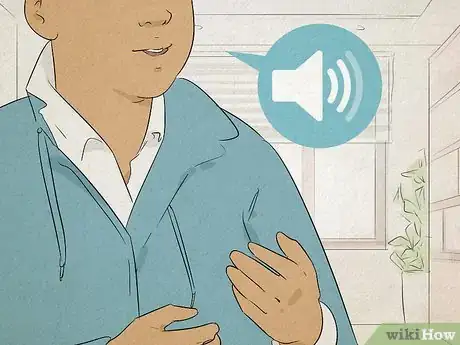wikiHow is a “wiki,” similar to Wikipedia, which means that many of our articles are co-written by multiple authors. To create this article, 50 people, some anonymous, worked to edit and improve it over time.
This article has been viewed 308,752 times.
Learn more...
Whether you are visiting a grandparent or you are a social worker who deals with older adults from time to time, age-related health problems can present a barrier to effective communication. Chronic conditions, such as dementia and hearing loss, as well as the effects of medication can complicate conversations and understanding. During periods of diminished lucidity, interactions can create a frustrating and seemingly helpless experience. However, there are techniques you can use to help facilitate interaction with older adults to create a communication-friendly environment.
Steps
-
1Be aware of the person's health issues. Older adults may have health problems that add difficulty to speaking and understanding. Be sure you consider the person's health before you engage in communication. For example, they may have hearing problems, speech problems, and memory loss. These factors complicate communication. And remember, chronological age is not always a true indicator of a person’s health (see Warnings).[1]
-
2Be attentive to the environment in which you are communicating. Be sure to evaluate the environment in which you are communicating, which might have an effect on hearing and speech problems. Is there any disturbing background noise? Are many people speaking in the same room? Is there any intrusive music? Are there any distractions that could affect your communication? Ask the older adult if the environment is comfortable for them. If you sense any disturbance, try to move to a more peaceful and quiet location.[2]Advertisement
-
3Speak clearly and articulately, and make eye contact. Older adults may have trouble hearing. It is important to articulate your words and speak clearly. Direct your speech at the individual's face -- not to their side. Do not eat your words: move your mouth and pronounce each word carefully and precisely. When your tongue “dances” inside your mouth when you talk, you articulate more clearly. If your tongue “sleeps” and plays a passive role, you are more likely not articulating as well as you could.[3]
-
4Adjust your volume appropriately. There is a difference between enunciating and talking loudly. Learn to adapt your voice to the needs of the individual. Evaluate the environment and how it relates to the person’s hearing abilities. Don't shout simply because the listener is older. Treat the individual with respect by articulating and speaking at a comfortable volume that is suitable for both of you.[4]
-
5Use clear and precise questions and sentences. Do not hesitate to repeat or rephrase your sentences and questions if you sense there is an absence of comprehension. Complicated questions and sentences may confuse older adults who have short-term memory or hearing loss. Clear and precise constructions are easier to comprehend.[5]
- Use direct questions: "Did you have soup for lunch?" "Did you have salad for lunch?" Instead of: "What did you have for lunch?" The more precise you are in your language, the less difficulty the elderly have in understanding.
- Reduce the "noise" in your sentences and questions. Limit your sentences and questions to 20 words or less. Don't use slang or filler words and phrases. ("Like," "well," and "you know" are a few examples.) Keep your sentences brief and direct to the point.
- Avoid the confusion of mixed ideas and questions. Try to define your ideas and questions logically. If you mix ideas, it may be confusing for the older adult to understand. Express one idea and message at a time. For example, "It is a good idea to call John, your brother. Later, we can call Susan, your sister." A more complicated construction would be: "I think we should call your brother, John, first, and then later we could call your sister, Susan."
-
6Employ visual aids, if possible. If an older adult has a hearing or memory problem, it is important to be creative. Visual aids help. Show the individual what or who you are talking about. For example, it may be better to say, "Is there any pain in your back (pointing to your back)? Is there any pain in your stomach (pointing to your stomach)?" instead of simply asking "Do you have any pain or discomfort?"[6]
-
7Take it slow, be patient, and smile. A sincere smile shows that you are understanding. It also creates a friendly environment in which to communicate. Remember to pause between sentences and questions. Give the individual an opportunity to understand and digest information and questions. This is a particularly valuable technique if a person has memory loss. When you pause, you show respect and patience.[7]
Community Q&A
-
QuestionHow do I show nice gestures to a patient at my care home?
 Community AnswerShare stories about your family and interests and ask your patients about their loved ones. Listen to music together, work on an art project or take a walk around the home to show you care.
Community AnswerShare stories about your family and interests and ask your patients about their loved ones. Listen to music together, work on an art project or take a walk around the home to show you care. -
QuestionHow do I care for a person who has suffered a stroke?
 Community AnswerThis article may be of some help: how to help a loved one recover from a stroke.
Community AnswerThis article may be of some help: how to help a loved one recover from a stroke. -
QuestionHow can I be confident when I speak with adults?
 Community AnswerSpeak clearly and respectfully. Do not use slang and articulate your speech.
Community AnswerSpeak clearly and respectfully. Do not use slang and articulate your speech.
Warnings
- Never act like the elderly person who you are with is ancient (even if they are!) or "obsolete". Elderly people have feelings too, and are human beings just like everyone else. Treat them with respect and kindness.⧼thumbs_response⧽
- Not all older adults have all of these problems! There are many senior citizens who are in practically perfect mental and physical health. Only use these steps if you sense the older adult has trouble communicating, otherwise you may offend him or her.⧼thumbs_response⧽
References
- ↑ https://www.apa.org/pi/aging/resources/guides/older
- ↑ https://www.aafp.org/fpm/2006/0900/p73.html
- ↑ https://www.aafp.org/fpm/2006/0900/p73.html
- ↑ https://www.psychologytoday.com/us/blog/communication-success/201411/how-communicate-effectively-older-adults
- ↑ https://www.nia.nih.gov/health/understanding-older-patients
- ↑ https://www.nia.nih.gov/health/understanding-older-patients
- ↑ https://www.nia.nih.gov/health/tips-improving-communication-older-patients


































































